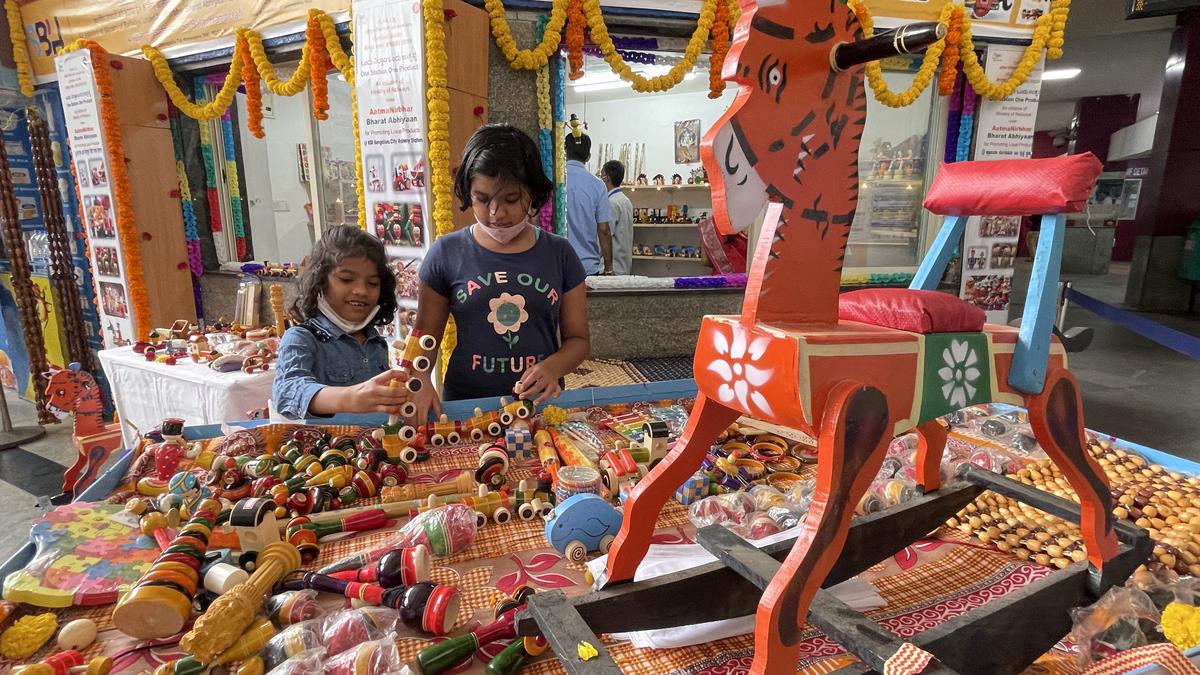
It’s a tough road ahead for Channapatna’s toy makers Premium
The Hindu
The row of lacquered wooden horses stabled outside the Jai Sri Navaneetha Krishna Toys Emporium seem to look forlornly out onto the main road, empty, save for the occasional truck or tractor trundling past. Inside, K Channappa Gowda, the proprietor of this toy shop in Channapatna, looks equally forlorn; his business has fallen by nearly 80-90%, since the Bengaluru-Mysuru Expressway was inaugurated on March 12, 2023.
The row of lacquered wooden horses stabled outside the Jai Sri Navaneetha Krishna Toys Emporium seem to look forlornly out onto the main road, empty, save for the occasional truck or tractor trundling past. Inside, K. Channappa Gowda, the proprietor of this toy shop in Channapatna, looks equally forlorn; his business has fallen by nearly 80-90% since the Bengaluru-Mysuru Expressway was inaugurated on March 12, 2023.
“Channapatna is known for being the house of toys,” he says, recalling how there was a time in the not-so-distant past when travellers on their way to Mysuru, Madikeri or Mandya inevitably made a pit stop at Channapatna. “Now business is down as no vehicles are coming into this town,” recalls Mr Gowda, who has been running his toy business for nearly 50 years. “Only old customers who already know about this shop are now coming here.”
Gowda is one of the many inhabitants of this small town in Karnataka’s Ramanagara district who have been struggling to make ends meet since the expressway opened four months ago. Like many other iconic local businesses, including the restaurants serving thatte idlis, Mysore Pak and Maddur vadas, all staple stops for road trippers, the Channapatna toy-makers have been badly affected by this new expressway.
Karthik Vaidyanathan, principal designer and founder of Varnam Craft Collective, a craft design studio with stores in both Bengaluru and Mysuru, says that with few signages and no promotion on the new highway, people end up simply bypassing the town. “It has been 12 years since I started working with artisans here. But it continues to be a struggle because they have been dealing with so many issues, one after the other,” he says, listing some of them — demonetisation, the GST increase and then COVID-19. “This is another big blow,” believes Mr. Vaidyanathan.
It all began with a wooden tiger. At least that is how the legend goes, says M. Bhupathy, the managing trustee and secretary of the Shilpa Trust, a social welfare organisation established in 1992 to help the artisans of Channapatna. “A guest from Persia gifted this toy to Tipu Sultan,” recounts Bhupathy, who runs a unit at the Channapatna Craft Park. Apparently, the Tiger of Mysore, as the 18th Century ruler who fought the British was called, was so enamoured with the craft that he sought to impart it to the artisans of his own land, inviting Persians to come and train these local artisans, says Mr Bhupathy, the 5th generation of his family to be associated with this craft.
Over the centuries, the wooden lacquerware industry of Channapatna has gone through a rather tumultuous journey, dealing with multiple changes and upheavals. Despite positive developments, such as more consumer awareness of the craft, focused design interventions, a GI certification, government-led training programmes, a sizeable export market and even the establishment of the crafts park, the first of its kind in the country, the struggle continues for many artisans.
The reasons for this are the usual ones faced by craftspeople all over India: changing market preferences, the influx of cheap imports from China, inadequate government support, lack of innovation and quality control in some clusters, and faults in the supply chain. This, in turn, has led to artisans abandoning their craft and becoming daily wage or industrial workers. “Many of them join the ready-made garment business in Bengaluru,” points out Mr. Bhupathy, who puts the current number of artisans at around 5,000. “The number of artisans is decreasing day by day,” he reiterates.











